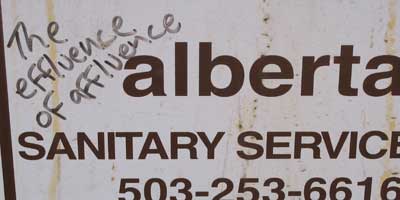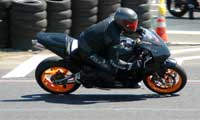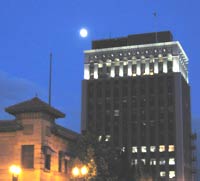I rocked some brown shoes, white socks, olive green shorts and a black shirt at work. Top it off with sink-washed hair and 6-day stubble. I may be getting too casual. Or lazy.
Month: June 2006
Effluence

Tommy’s Track Day

Yesterday Glin and I served as pit crew for Tom while he finished his last track day and class at the Portland International Raceway. We weren’t that great as far as pit crews go – we were usually still out walking around the track when Tommy finished a session. We did however circumnavigate the track on the inside and outside, took a few pictures (thanks Hilly) and used zip ties on non-bike things.
This was the first time I’ve been at a bike track and I had a blast. Being 4 feet away from a bike going over 160mph is pretty cool, and the fence and concrete were nice. Hearing a set of 600cc engines whiz by then have a liter bike buzz by, having your head tugged when a group moves past, watching a downed bike slide like a curling stone – all cool. There were a couple bad-asses on the course that were just amazing to watch, but it was also fun to see a friend out doing really well, and looking cooler on the track (thanks to the all black with orange wheels and lego-orange visor) than many of the other riders.
I’ve put up a gallery of still shots that I took with my sister’s D70, her wide-angle lens, and her 70-300mm (sweet), but there are several “in a series” shots that I want to stitch together somehow to show the motion and movement.
Dunlap Wedding Photos
I’ve posted my photos from Scott and Stephanie’s lovely wedding in Bellingham. I always miss the people, but this time I realized that I missed the city itself too. Congrats and best wishes.
Johnny Winter and Hank III
I get a stupid grin whenever I hear a pedal steel guitar being play well.
In the last two weeks, I’ve seen Johnny Winter and Hank III in concert. Johnny Winter, the albino Texas blues guitarist, was fun, but he’s in declining health and did not put on the best of shows. He could still rock, and he soloed quite well, but he often got tripped up in some of his riffs. Sitting for the whole show can make it difficult for the musician to sell excitement, so his band had to work overtime setting the pace and attitude. His bass player, Scott Spray, was amazing. It’s rare to see a bass player that can solo well in blues music without sounding like a technical-jackass. His solos and the flourishes he added to the show were excellent, and complimented Johnny. Scott also came across as the guy running the show – he seemed to keep time, manage the ailing guitarist, and was just generally all over the place. I went with my dad, whose Johnny Winter albums I’ve been listening to for several years. It was one of those “once in your life” type concerts, and it looks like we made it just in time.

Last night, coworkers Max, Alan and I all went to see Hank III and Ass Jack. I kidded Alan who was still in work clothes before we left that he’d be the only person in a polo shirt, but after the opening act, a relatively normal group of people filled the crowd. It was a bit strange seeing punk, rock, and country music fans all in the same place, but it worked, and everyone enjoyed it. I’ve listened to Straight to Hell a couple of times, but upon seeing the band live, I started to think that maybe the rebel country thing may be a bit contrived. The upright bass player looked like Animal from the muppets, and all the musicians were really good. Like nearly top-of-their-game Nashville good. They had nice equipment, and Hank rocked a set of acoustic and electric Guild guitars.
Towards the end of the set, the genre shifted from country to punk, and it was good. Seeing a fiddle player thrashing with punk music was cool, especially as strands from his bow would snap and hang from the bow. The pedal steel guitar player was also great and sounded really cool in second set. Really a great show – partly because of the strange demographic. I’m glad Max and Alan dragged me to it.
Art Deco in Portland

The Art Deco style manifested itself in urban American landscapes between the two world wars, and symbolized the economic and social growth of the time (Retropolis). Art Deco combined a modern take on historical themes, including the rounding of hard edges, and often featured dramatic and stylized ornament in stone and brass. Prominent examples of the style are still primary in the architectural psyche of America, but Portland, Oregon has a noticeable shortage of true Art Deco buildings. Instead, there are a few minor examples in downtown Portland, and smaller, diluted examples scattered in commercial offices and industrial buildings of southeast Portland (Bosker, p.135).
A few elements of the style can be seen in various parts of the city. The Charles F. Berg building (Fig. 1) includes the use of streamlined edges, modernized facades with Mayan themes, and brass and gold detailing that typify Art Deco (King, p.37). More common in Portland are Art Deco ornamentation in doorways and on building cornices. The Gus Solomon Federal Courthouse has very stylized doorways (Fig. 2) and interior, but the building itself is more subdued. The South Park Blocks have a couple examples of Art Deco themes with the Church of Christ, Scientist on SW Park, and the neighboring Jeanne Manor (Fig. 3) and Blackstone Hall (Fig. 4). These brick buildings employ Art Deco themes but are not blatant displays of Deco style seen in other cities like New York, Los Angeles, or Miami (Decopix).
There are more examples of Art Deco style when you cross the Willamette River. Besides the dominant Terminal Sales Building (background, Fig. 5), minor examples can be found in commercial buildings, more commonly in the form of the streamlined style and stylized brass signage.
Portland is lacking grand examples of Art Deco. Ritz speculates that this is because the boom surrounding the Lewis & Clark Exposition left an abundance of buildings so there was no demand when Art Deco was in style and because the most active architects of the time were adherents of the Classical Revival and Chicago styles (Ritz, p.9). Additionally, the lack of major natural disasters has preserved many of the older buildings in downtown Portland.
The niche of Art Deco buildings that represented the economic surge of the 1920s is lacking in Portland. Many buildings in Portland do contain elements of Art Deco, however the overwhelming local preference is classical revival with a few additions.
For more pictures, see this gallery
Bosker, Gideon. 1985. Frozen Music. Western Imprints, Portland
King, Bart. 2001. An Architectural Guidbook to Portland. Gibbs Smith, Layton.
Juster, Randy, “DecoPix” – http://www.decopix.com [accessed 27 May 2006]
Art Deco Style http://www.geocities.com/gappy21c/adstyle.html [accessed 27 May 2006]
Retropolis, “Art Deco Architecture” http://www.retropolis.net/history.html [accessed 27 May 2006]
Ritz, Richard. 1991. An Architect Looks At Downtown Portland. The Greenhills Press, Portland.
On Printing
Tuesday’s lecture in my map design class covered printing/press issues. While much of the lecture was for historical reference only, I was surprised how much I already knew because of my college summer job working for Shields Printing. The printing process, quality control, on-job injuries, smack-talk about which WCW wrester was best and 115F temperatures all turned up in this last lecture. Plus, some of the darkroom techniques I learned in high school came in handy when looking at how final prints are set up. A classmate used the word syncronicity to describe the weird combinations of things she was noticing that afternoon and I thought it was very syncronicitous that she through out that word.
1 stop
I drove home from PSU last night without having to stop for a single light. The only stop I made was at a stop sign on 26th and Alberta. I’ve driven segments of that route before without stopping, but never all at once. I can only assume the lack of traffic after midnight was the main reason.
Six Stories on Alberta
The last Concordia Neighborhood newsletter mentioned that the lot on NE 20th and Alberta St (across from don Poncho) was recently sold for $1.2 million. The plan is to put in a 6 story apartment/condo building with 3 commercial spaces on the ground floor. People are going to be pissed – and maybe they should be, but I’m kind of excited.
Why? I’m yuppie scum It would add space for another 100+ residents that, god forbid, if Alberta Street goes out of style, will at least provide enough of an immediate community to support some of the local businesses. Why is that good? Because I want them to stay open. Maybe 4 Thai restaurants is overkill (if you’re looking to put in an Indian/Mughal restaurant – consider 24th and Alberta… please?), but the abundance of small local businesses can only survive as long as people come from outside our neighborhood to support these places. (thanks Al)
On Usonia
I’m doing a book review of Roland Reisley’s Usonia New York; Building a community with Frank Lloyd Wright for my urban landscapes course, but in order to distill it in to a five minute powerpoint, I have to talk through it a little.
The book is quite interesting especially at this point in my life and the lives of my friends. Some are looking at escaping the city to raise a family in the safety of the suburbs, and others are struggling with the concept of community. Most of the book is dedicated to the formation and design aspects and very little on why the community has persisted – something that I’m most interested in. It has certainly turned me off of the idea of cooperative living.
Usonia was and is one of the few successful cooperative communities in the United States, and is unique for a variety of reasons. The community was the the brainchild of David Henken, who wanted to recreate the work and ideas of Frank Lloyd Wright’s Broadacre community and Usonia home plans. He and his wife dedicated themselves to Wright’s tutelage and pitched the idea to friends and family, and ultimately created enough interest to start a cooperative development that was under the guidance of Wright.
The co-op struggled to find conventional funding, struggled to come up with materials, struggled to attract enough inhabitants, and struggled to pay bills. But through all these struggles, they formed a unique suburban community with some interesting architecture and a unique identity.
In the context of the Landscape class, what strikes me about Usonia is the scale of the community. Each lot was 1.2ish acres, and every picture of a house in the book was in its own zone of privacy. There were no pictures where you can see a neighbor’s house in the distance.
Additionally, the changes in administration from co-op owned land and homes to individual owned homes turned this from a real cooperative community to a fancy suburb with good block parties and nicer homes.
Wright’s influence in the community was obvious at the onset, but within 5 years of groundbreaking, he was done with it and many of the newer inhabitants were done with him. Many of the author’s quotes regarding the organicism of the community and cooperative spirit excluded Wright’s own ideals of Usonia.
I personally have a love/hate relationship with Wright’s work. The homes at Usonia are quite amazing though – and I’m surprised at the scale of them. Many of the homes were built with tiny bedrooms, tiny kitchens, and expansive living space. The tiniest bit of environmental determinist in me wonders what influence his design had on the activity of Usonians in their community.
I’d post some of my scans from the book but worry about copyright.